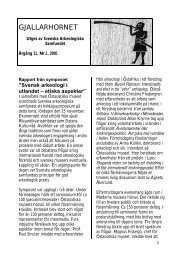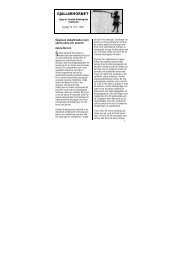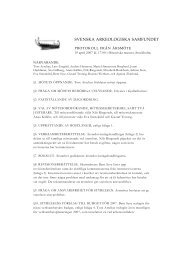Fields, Funerals and Furnaces Anna Arnberg - Svenska ...
Fields, Funerals and Furnaces Anna Arnberg - Svenska ...
Fields, Funerals and Furnaces Anna Arnberg - Svenska ...
Create successful ePaper yourself
Turn your PDF publications into a flip-book with our unique Google optimized e-Paper software.
8 <strong>Anna</strong> Arnherg<br />
KRÄKLINGBO PARISH: THE FOREST FIRE AND THE FOLLOWING<br />
SURVEY<br />
For some days in July 1992, the forests in the eastern parts of Kräklingbo parish<br />
<strong>and</strong> the western parts of Gammelgarn parish were on fire. On Thursday the 9'",<br />
when the media started reporting these fires, there was a fresh breeze coming<br />
from the south-west <strong>and</strong> the fire spread rapidly from its starting-point by the hillfort<br />
of Torsburgen over an area of 20 square kilometres (Fig. 2). Despite the<br />
enormous efforts of fire-fighters, military personnel <strong>and</strong> volunteers, it was not<br />
until three days later that the flames were brought under control, <strong>and</strong> it was a few<br />
days after that before the fire was completely extinguished (Fig. 1). It was now<br />
confirmed that vast areas had been heavily scorched, occasionally to such a degree<br />
that the covering soil had disappeared, displaying the white limestone bedrock<br />
(Carlsson 1992, 1993:17;Johansson 1993:2; Lindquist 1993:7; Östergren 1992:44).<br />
Rather miraculously, no people were injured <strong>and</strong> no houses were damaged by<br />
the fire (Östergren 1992:44). Though the fate of the woodl<strong>and</strong>s was not as benign,<br />
the emotional <strong>and</strong> economic disasters were nevertheless severe (Eliason 1993:11).<br />
As it was feared that the ancient remains might have suffered the same fate, a<br />
survey was planned. Aiming to make use of the preferable conditions for spotting<br />
features formerly hidden by vegetation, it was conducted as soon as the flames<br />
had been put out (Östergren 1992; Carlsson 1992, 1993). It was concentrated to<br />
the fire lines <strong>and</strong> the surveyors concluded that 40 ancient remains showed firerelated<br />
damage, a number much lower than expected. It was also discovered that<br />
only a few localities, amongst them a burial ground from the Pre-Roman Iron<br />
Age, were so badly damaged that rescue excavations had to be carried out<br />
(Carlsson 1993:17; Zerpe 1999; Östergren 1992:45).<br />
THE FOSSILIZED FIELDS OF KRÄKLINGBO<br />
The survey confirmed the enormous power of the flames <strong>and</strong> their ability to<br />
transform the l<strong>and</strong>scape. The area<br />
south of the farm of Ekeskogs, about<br />
1,5 kilometres south-east of the<br />
church of Kräklingbo, was covered<br />
with pine trees before the fire (Fig.<br />
2). Now however, large parts of the<br />
forest were wiped out <strong>and</strong> the<br />
covering soil reduced to a thickness<br />
of between 5 <strong>and</strong> 20 cm (Johansson<br />
1993:13). Before 1992, only<br />
a few stone walls (Sw. stenvallar),<br />
Current Swedish Archaeology, Vol. l3, 2005<br />
Fig. I. Conscripts fighting the forest fire in<br />
Kräklingbo. Photograph by Ulf Glimfalk<br />
(Lindciuist l 993.10).






